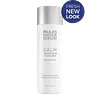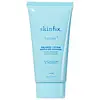Paula's Choice Calm Redness Relief Cleanser Versus Skinfix Barrier+ Ceramide + Ectoin Gentle Gel Cleanser
What's inside
What's inside
 Key Ingredients
Key Ingredients

 Benefits
Benefits

 Concerns
Concerns

 Ingredients Side-by-side
Ingredients Side-by-side

Water
Skin ConditioningSodium Laureth Sulfate
CleansingGlycol Stearate
EmollientMethyl Gluceth-20
HumectantGlyceryl Stearate
EmollientChamomilla Recutita Flower Extract
MaskingAloe Barbadensis Leaf Juice Powder
Skin ConditioningCocamidopropyl Betaine
CleansingSodium Cocoyl Glutamate
CleansingDisodium Cocoyl Glutamate
CleansingSodium Hyaluronate
HumectantSodium PCA
HumectantHydroxyethylcellulose
Emulsion StabilisingCaprylyl Glycol
EmollientHexylene Glycol
EmulsifyingPropylene Glycol
HumectantCitric Acid
BufferingPhytic Acid
Phenoxyethanol
PreservativeWater, Sodium Laureth Sulfate, Glycol Stearate, Methyl Gluceth-20, Glyceryl Stearate, Chamomilla Recutita Flower Extract, Aloe Barbadensis Leaf Juice Powder, Cocamidopropyl Betaine, Sodium Cocoyl Glutamate, Disodium Cocoyl Glutamate, Sodium Hyaluronate, Sodium PCA, Hydroxyethylcellulose, Caprylyl Glycol, Hexylene Glycol, Propylene Glycol, Citric Acid, Phytic Acid, Phenoxyethanol
Water
Skin ConditioningGlycerin
HumectantSodium Cocoyl Isethionate
CleansingCocamidopropyl Hydroxysultaine
CleansingSodium Lauroyl Methyl Isethionate
CleansingSodium Methyl Cocoyl Taurate
CleansingCocamidopropyl Betaine
CleansingSodium Methyl Oleoyl Taurate
CleansingLauryl Glucoside
CleansingCoco-Glucoside
CleansingCoconut Acid
CleansingJojoba Oil/Macadamia Seed Oil Esters
Skin ConditioningSodium Chloride
MaskingSodium Isethionate
CleansingEctoin
Skin ConditioningSqualene
EmollientOligopeptide-1
Skin ConditioningOligopeptide-2
Skin ConditioningOligopeptide-3
Skin ConditioningHexapeptide-11
Skin ConditioningCeramide EOP
Skin ConditioningPropanediol
SolventHydroxyectoin
BufferingNiacinamide
SmoothingAmylopectin
Bacillus
Skin ConditioningFolic Acid
Skin ConditioningSodium Hyaluronate
HumectantPentylene Glycol
Skin ConditioningInulin
Skin ConditioningPhytosteryl Macadamiate
Skin ConditioningLecithin
EmollientAcetyl Glutamine
Skin ConditioningChamomilla Recutita Flower Extract
MaskingLithothamnion Calcareum Extract
Skin ConditioningLactic Acid
BufferingPhytosterols
Skin ConditioningAlpha-Glucan Oligosaccharide
CleansingSodium Lauroyl Lactylate
EmulsifyingTocopherol
AntioxidantSodium Benzoate
MaskingCaprylyl Glycol
EmollientPolyglutamic Acid
Skin ConditioningCeramide NP
Skin ConditioningCeramide AP
Skin ConditioningPhytosphingosine
Skin ConditioningCholesterol
EmollientCarbomer
Emulsion StabilisingCitric Acid
BufferingXanthan Gum
EmulsifyingPotassium Sorbate
PreservativeEthylhexylglycerin
Skin ConditioningPhenoxyethanol
PreservativeWater, Glycerin, Sodium Cocoyl Isethionate, Cocamidopropyl Hydroxysultaine, Sodium Lauroyl Methyl Isethionate, Sodium Methyl Cocoyl Taurate, Cocamidopropyl Betaine, Sodium Methyl Oleoyl Taurate, Lauryl Glucoside, Coco-Glucoside, Coconut Acid, Jojoba Oil/Macadamia Seed Oil Esters, Sodium Chloride, Sodium Isethionate, Ectoin, Squalene, Oligopeptide-1, Oligopeptide-2, Oligopeptide-3, Hexapeptide-11, Ceramide EOP, Propanediol, Hydroxyectoin, Niacinamide, Amylopectin, Bacillus, Folic Acid, Sodium Hyaluronate, Pentylene Glycol, Inulin, Phytosteryl Macadamiate, Lecithin, Acetyl Glutamine, Chamomilla Recutita Flower Extract, Lithothamnion Calcareum Extract, Lactic Acid, Phytosterols, Alpha-Glucan Oligosaccharide, Sodium Lauroyl Lactylate, Tocopherol, Sodium Benzoate, Caprylyl Glycol, Polyglutamic Acid, Ceramide NP, Ceramide AP, Phytosphingosine, Cholesterol, Carbomer, Citric Acid, Xanthan Gum, Potassium Sorbate, Ethylhexylglycerin, Phenoxyethanol
 Reviews
Reviews

Ingredients Explained
These ingredients are found in both products.
Ingredients higher up in an ingredient list are typically present in a larger amount.
Caprylyl Glycol is a humectant and emollient, meaning it attracts and preserves moisture.
It is a common ingredient in many products, especially those designed to hydrate skin. The primary benefits are retaining moisture, skin softening, and promoting a healthy skin barrier.
Though Caprylyl Glycol is an alcohol derived from fatty acids, it is not the kind that can dry out skin.
This ingredient is also used as a preservative to extend the life of products. It has slight antimicrobial properties.
Learn more about Caprylyl GlycolChamomilla Recutita Flower Extract comes from the Chamomile flower.
Chamomile is rich in antioxidants and has anti-inflammatory properties. Several compounds found in chamomile help with soothing, such as bisbolol.
Antioxidant components in chamomile make it an effective ingredient to help slow the signs of aging. Antioxidants help fight free-radical molecules, or molecules that may damage your skin.
Essential oils from chamomile have been found to improve wound healing due to its antimicrobial properties.
Ancient Greeks and Egyptians used Chamomile to treat skin redness and dryness. Chamomile has also been used to help treat stomach issues.
Learn more about Chamomilla Recutita Flower ExtractCitric Acid is an alpha hydroxy acid (AHA) naturally found in citrus fruits like oranges, lemons, and limes.
Like other AHAs, citric acid can exfoliate skin by breaking down the bonds that hold dead skin cells together. This helps reveal smoother and brighter skin underneath.
However, this exfoliating effect only happens at high concentrations (20%) which can be hard to find in cosmetic products.
Due to this, citric acid is usually included in small amounts as a pH adjuster. This helps keep products slightly more acidic and compatible with skin's natural pH.
In skincare formulas, citric acid can:
While it can provide some skin benefits, research shows lactic acid and glycolic acid are generally more effective and less irritating exfoliants.
Most citric acid used in skincare today is made by fermenting sugars (usually from molasses). This synthetic version is identical to the natural citrus form but easier to stabilize and use in formulations.
Read more about some other popular AHA's here:
Learn more about Citric AcidCocamidopropyl Betaine is a fatty acid created by mixing similar compounds in coconut oil and dimethylaminopropylamine, a compound with two amino groups.
This ingredient is a surfactant and cleanser. It helps gather the dirt, pollutants, and other impurities in your skin to be washed away. It also helps thicken a product and make the texture more creamy.
Being created from coconut oil means Cocamidopropyl Betaine is hydrating for the skin.
While Cocamidopropyl Betaine was believed to be an allergen, a study from 2012 disproved this. It found two compounds in unpure Cocamidopropyl Betaine to be the irritants: aminoamide and 3-dimethylaminopropylamine. High-grade and pure Cocamidopropyl Betaine did not induce allergic reactions during this study.
Learn more about Cocamidopropyl BetainePhenoxyethanol is a preservative that has germicide, antimicrobial, and aromatic properties. Studies show that phenoxyethanol can prevent microbial growth. By itself, it has a scent that is similar to that of a rose.
It's often used in formulations along with Caprylyl Glycol to preserve the shelf life of products.
Sodium Hyaluronate is hyaluronic acid's salt form. It is commonly derived from the sodium salt of hyaluronic acid.
Like hyaluronic acid, it is great at holding water and acts as a humectant. This makes it a great skin hydrating ingredient.
Sodium Hyaluronate is naturally occurring in our bodies and is mostly found in eye fluid and joints.
These are some other common types of Hyaluronic Acid:
Learn more about Sodium HyaluronateWater. It's the most common cosmetic ingredient of all. You'll usually see it at the top of ingredient lists, meaning that it makes up the largest part of the product.
So why is it so popular? Water most often acts as a solvent - this means that it helps dissolve other ingredients into the formulation.
You'll also recognize water as that liquid we all need to stay alive. If you see this, drink a glass of water. Stay hydrated!
Learn more about Water